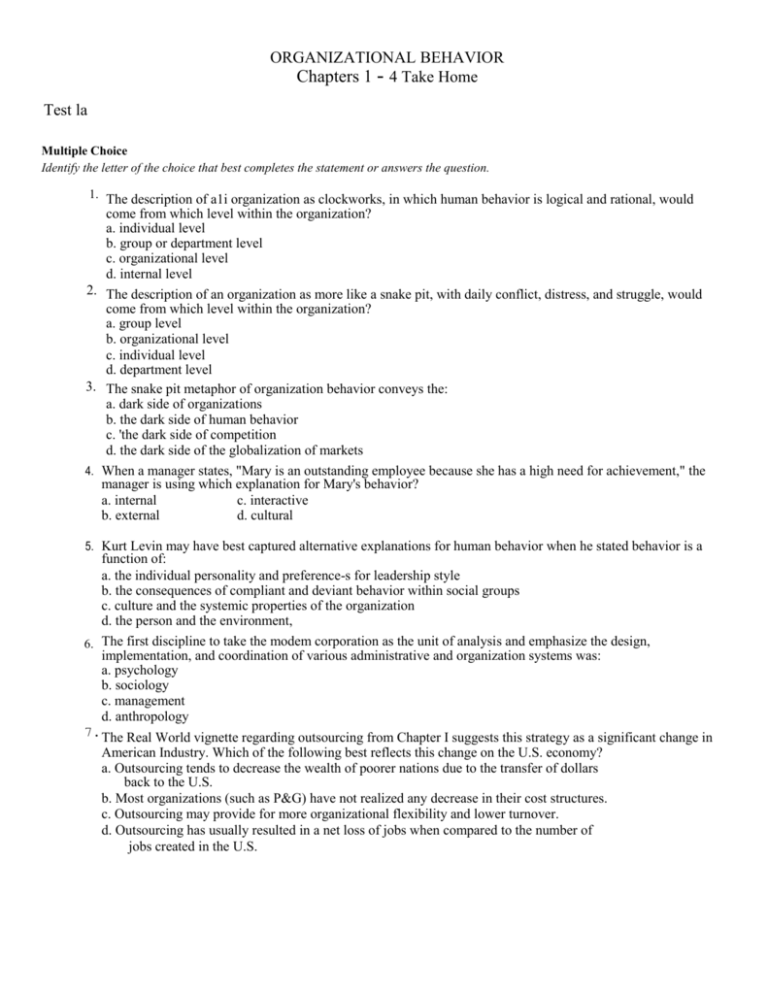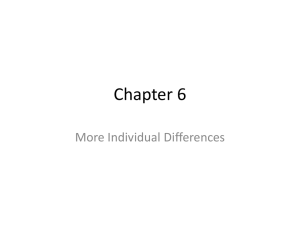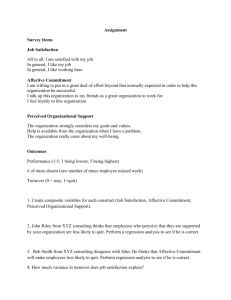organizational behavior
advertisement

ORGANIZATIONAL BEHAVIOR Chapters 1 - 4 Take Home Test la Multiple Choice Identify the letter of the choice that best completes the statement or answers the question. 1. The description of a1i organization as clockworks, in which human behavior is logical and rational, would come from which level within the organization? a. individual level b. group or department level c. organizational level d. internal level 2. The description of an organization as more like a snake pit, with daily conflict, distress, and struggle, would come from which level within the organization? a. group level b. organizational level c. individual level d. department level 3. The snake pit metaphor of organization behavior conveys the: a. dark side of organizations b. the dark side of human behavior c. 'the dark side of competition d. the dark side of the globalization of markets 4. When a manager states, "Mary is an outstanding employee because she has a high need for achievement," the manager is using which explanation for Mary's behavior? a. internal c. interactive b. external d. cultural 5. Kurt Levin may have best captured alternative explanations for human behavior when he stated behavior is a function of: a. the individual personality and preference-s for leadership style b. the consequences of compliant and deviant behavior within social groups c. culture and the systemic properties of the organization d. the person and the environment, 6. The first discipline to take the modem corporation as the unit of analysis and emphasize the design, implementation, and coordination of various administrative and organization systems was: a. psychology b. sociology c. management d. anthropology 7. The Real World vignette regarding outsourcing from Chapter I suggests this strategy as a significant change in American Industry. Which of the following best reflects this change on the U.S. economy? a. Outsourcing tends to decrease the wealth of poorer nations due to the transfer of dollars back to the U.S. b. Most organizations (such as P&G) have not realized any decrease in their cost structures. c. Outsourcing may provide for more organizational flexibility and lower turnover. d. Outsourcing has usually resulted in a net loss of jobs when compared to the number of jobs created in the U.S. 8. In an open system the transformation or conversion of inputs to outputs is accomplished with: a. technology b. task structure 0 c. borrowed financial resources d. robots The core technology of a university is its: a. student brain power 9. b. library, laboratories, classrooms, and computer equipment c. registration and billing systems d. athletic programs The use of a wide range of tools, knowledge, and/or techniques used to transform inputs into outputs is called: a. task environment 10. b. structure c. the mission d. the technology 11. The Hawthorne Studies uncovered the importance of: a. the workflow and scheduling of work for production efficiency b. delegating authority downward and throughout the organization c. the informal organization and its impact on productivity d. viewing an organization as clockworks 12. The largest sector of the 10.9 trillion dollar U.S. economy is the: a. manufacturing nondurable goods b. manufacturing durable goods c. service sector d. government purchases (local, state, federal) 13. Which of the following organizations highlighted in the Thinking Ahead feature of Chapter 2 (Challenges for Managers) best reflects a response to the major challenge of technological innovation? a. The Coca-Cola Company b. Whole Foods Market, Inc. c. Pixar Animated Studios d. Virgin Group Ltd. 14. A transnational organization is one where: a. an organization's nationality is held strongly in the consciousness of managers even though the organization competes on a global scale b. the global viewpoint supersedes national issues c. the global and national interests are linked in an overriding perspective d. a prevalent ethnic viewpoint begins to be held strongly in the consciousness of managers The work of Hofstede is important because his studies revealed that more differences in work-related attitudes 15. can be explained by: a. gender c. national culture b. profession d. age 16. Hofstede's cross-cultural research found that Japanese managers valued: a. high risk taking b. group decisions c. a short-time perspective d. individualism 17. According to Hofstede's research, the country displaying cultural characteristics most similar to the U.S. is: a. Japan b. Sweden c. Italy d. Canada 18. The globalization of business and changing demographic trends will present organizations with a tremendously culturally diverse workforce which represents the risk that: a. prejudices and stereotypes will prevent managers and employees from developing a synergy that can benefit the organizations b. families will not be left intact c. values will begin to erode d. opportunities will not be available 19. Which generation of workers tends to strive for moral rights in the workplace and take a more activist position regarding employee rights? a. baby boomers b. silent generation c. Generation Y d. Generation X 20. An ethical theory that emphasizes the nature and characteristics of an act is; a. cultural based b. motive-based c. consequence-based d. rule-based 21. The implicit or explicit demands for sexual favors by threatening negative job-related consequences or promising job-related rewards is considered: a. gender harassment b. biased sexual force c. sexual coercion d. sexual exploitation 22. When the Japanese questioned the salaries of American CEOs during a time when many companies were'in difficulty and laying off workers, they were making their judgments based upon: a. utilitaria1;l justice b. distributive justice c. procedural justice d. rule-based justice 23. Approximately what percent of computer innovations either fail or are abandoned before completion? a. 10% b. 22% c. 42% d. 52% 24. Breaking larger office facilities into a network of smaller workplaces that are located close to employees' homes is known as what type of work arrangement? a. hoteling b. satellite offices c. cellular offices d. reservations 25. A work arrangement where employees share an office and have mobile file cabinets and lockers for personal storage with space being reserved rather than permanent!)! assigned refers to: a. hoteling b. satellite offices c. temporary cells d. permanent reservations 26. Technological change and innovation positively impact jobs and employees through all of the following except: a. greater technical skill requirements b. enhanced concern of job loss c. increased job autonomy and responsibility d. greater potential for pay increase 27. Generalized self-efficacy is the general: a. feeling of one's self-worth b. extent to which people base their behavior on cues from other people and situations c. belief about one's own capabilities to deal with the events and challenges that make life demanding d. belief about self or situational control over what happens to them 28. When predicting behavior, an important idea to remember concerns the extent to which a situation overwhelms the effects of individual personalities by providing cues for appropriate behavior. This type of situation is called a: \ 29. 30. 31 32 a. weak situation b. weak individual difference c. strong individual difference d. strong situation According to the MBTI a successful top executive is likely to be alan: a. introvert, intuitor, feeler, and perceiver b. introvert, sensor, thinker, and perceiver c. extrovert, intuitor, feeler, and judger d. extrovert, sensor, thinker, and judger According to the Jungian approach to personality, the basic preference that reflects what we pay attention to or how we prefer to gather information is: a. extraversion/introversion b. sensing/intuiting c. thinking/feeling d. judging/perceiving In which of the following situations are situational cues and social context most formalized? a. job interview b. employee coaching session c. on-the-job instruction for new employees d. employee briefing at start of work shift A supervisor's high expectations of a new employee and the subsequent high performance of that employee is known as: a. impression management b. stereotyping c. perceptual bias d. self-fulfilling prophecy 33, Increasing workforce diversity is likely to reduce _____ as a barrier to social perception. a. the primacy effect b. first-impression error c. selective perception d. stereotyping 34. Attributional biases implies that managers must: a. always be correct in their perceptions b. be very wary of the cognitive process in decision making c. know as much as possible about individual differences and determine the cause of behavior and perceived source of responsibility d. take into account the fundamental tendency for people to make external attributions for their behavior 35. An individual does not have an attitude until he or she responds to an entity on a: a. personal, cognitive, and behavioral basis b. cognitive, interactive, and behavioral basis c. behavioral, affective, and interactive, basis d. cognitive, behavioral, and affective basis 36. When one's attitudes and required job behavior conflict, _______may develop. a. affect 37. 38. 39. 40. 41. 42. b. attitude consonance c. behavioral tendency d. cognitive dissonance A major reason why attitudes derived from direct experience are so powerful is because: a. they become a heuristic to assist in decision making b. they are easily accessed and are active in our cognitive processes c. they are accessible through the left part of the brain which is more intuitive d. of the behavioral intention component of an attitude Which of the following is NOT one of the five things the attitude-behavior correspondence depends 1 a. attitude specificity b. attitude relevance c. social constraints d. the experimental model used to test the relationship The Jill measures: a. job performance b. attitude specificity c. employee absenteeism d. job satisfaction Job satisfaction and employee performance are likely to be positively related when: a. pay is linked to attendance b. non-participative techniques are used c. rewards are valued by employees and are tied directly to performance d. employee turnover is high Which of the following statements is true regarding job satisfaction and organizational commitment? a. They are reciprocally related. b. They are strongly positively related. c. Organizational commitment moderates the relationship between job satisfaction and performance. d. There is a curvilinear relationship between the two variables. Which statement best reflects the relationship between job satisfaction and individual performance? a. productive workers are satisfied b. satisfied workers are productive c. modest support for both A and B statements above but no simple direct relationship between satisfaction and performance has been found d. the strongest relationship between job satisfaction and performance has been found when satisfaction results in strongly valued rewards at1d then performance 43. The type of organizational commitment that is based on all individual's desire to remain in an organization is called: a. intentional commitment b. normative commitment c. affective commitment d. attitudinal commitment 44. According to recent research on organizational commitment in different countries, which type of workers displayed the highest level of affective commitment? a. U.S. b. Korean c. Japanese d. Chinese 45. Which of the following is not an instrumental value? a. helpfulness b. independence c. self-respect d. courage 46. Recent research found four values exerted the most influence on j ob choice decisions. Which of the following was not one of those values? a. achievement b. concern for others c. fairness d. pay 47. What type of work culture would you most likely find in -Iran? a. individualist culture b. work culture based on task accomplishment c. work culture based on contributions 'to loyalty d. collectivist culture 48. Your text states that the CEO of Johnson & Johnson compared the performance over a 40-year period of time for organizations that had devoted a great deal of time to ethics. Which of the following conclusions were supported by his investigation? a. Ethical behavior and job satisfaction were positively associated. b. Ethical behavior and sales growth were positively associated. c. Ethical behavior and the growth of market value were positively associated. d. Organizations with more time spent on ethical behavior have lower accounting returns and slow sales growth. 49.High-Mach persons are better at: a. cheating b. accepting orders from others c. behaving ethically d. building strong interpersonal relationships 50. According to research on Kohlberg's model of cognitive moral development, individuals at higher development stages are: a. more likely to cheat b. more likely to put expediency before ethics c. not able to distinguish right from wrong d. more likely to engage in whistle-blowing





